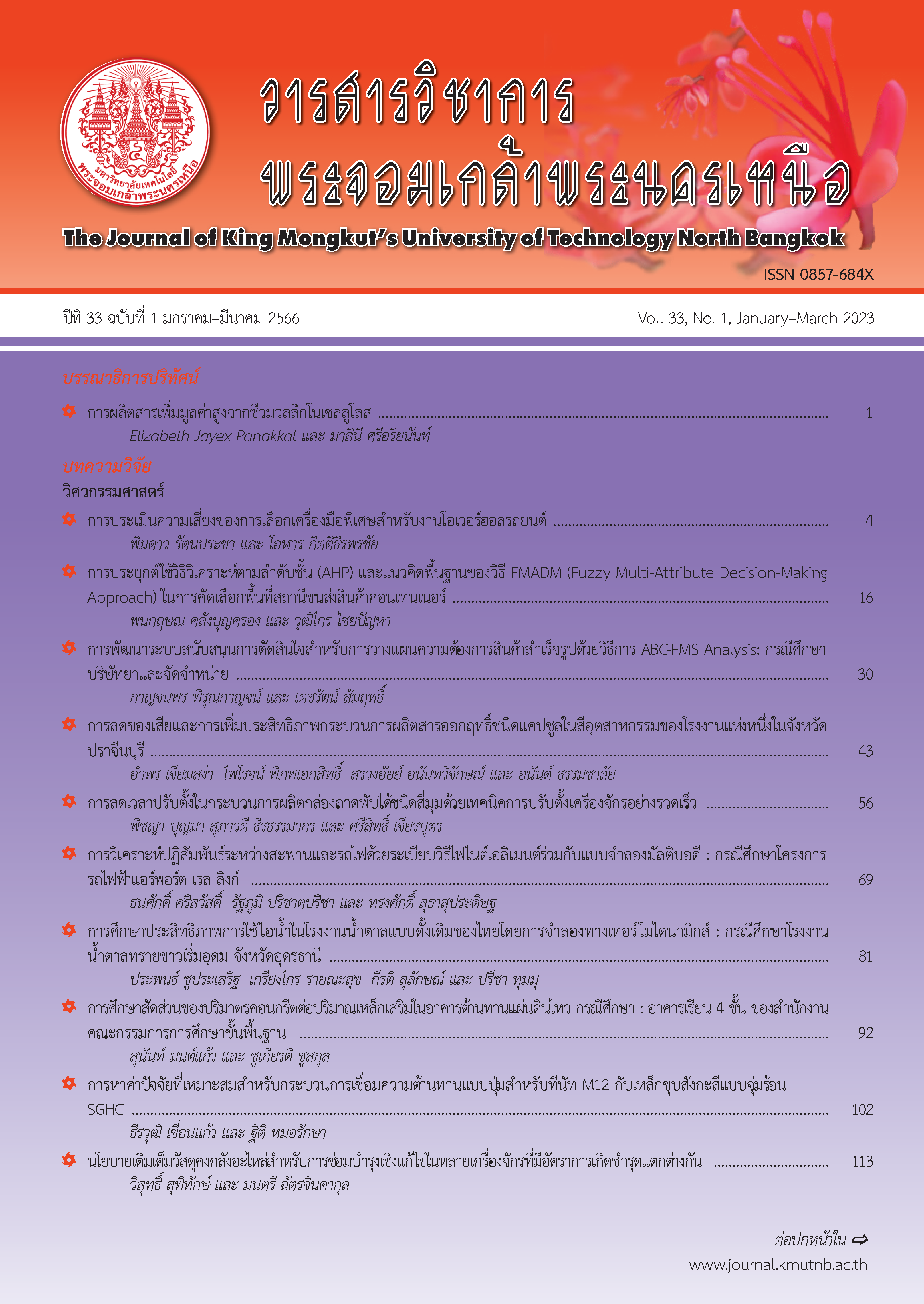ผลของปริมาณชานอ้อยต่อคุณภาพของเทอร์โมพลาสติกสตาร์ชจากกระบวนการกดอัดด้วยความร้อนสำหรับงานสาน
Main Article Content
บทคัดย่อ
การศึกษาวิจัยนี้มีวัตถุประสงค์เพื่อศึกษาปริมาณชานอ้อยที่เหมาะสมในการผลิตเทอร์โมพลาสติกสตาร์ช ศึกษาการอัดขึ้นรูปแผ่นเทอร์โมพลาสติกสตาร์ชผสมชานอ้อย และศึกษาแนวทางการนำแผ่นเทอร์โมพลาสติกสตาร์ชผสมชานอ้อยไปใช้ในงานสาน โดยปัจจัยที่ทำการศึกษา คือ ปริมาณชานอ้อยทดแทนแป้งมันสำปะหลัง แปรเป็น 6 ระดับ คือ ร้อยละ 0, 10, 20, 30, 40 และ 50 ของปริมาณแป้งมันสำปะหลัง ทำการวางแผนการทดลองแบบสุ่มสมบูรณ์ จะได้ทั้งหมด 6 สิ่งทดลอง นำสิ่งทดลองที่ได้มาศึกษาสมบัติทางความร้อนด้วยเทคนิค Differential Scanning Calorimetry (DSC) เพื่อนำไปขึ้นรูปเป็นแผ่นเทอร์โมพลาสติกสตาร์ชผสมชานอ้อยในกระบวนการกดอัดด้วยความร้อน แล้วนำสิ่งทดลองไปศึกษาค่าความชื้น ค่าแรงดึงสูงสุด และลักษณะที่ปรากฎโดยทดสอบการสานลายขัด ผลการศึกษาวิจัย พบว่า อุณหภูมิที่เหมาะสมในการกดอัดด้วยความร้อนเท่ากับ 220 องศาเซลเซียส และสิ่งทดลองที่มีปริมาณชานอ้อยทดแทนแป้งมันสำหลังร้อยละ 10 มีความเหมาะสมในการนำไปใช้ในงานสานมากที่สุด ซึ่งมีค่าความชื้นร้อยละ15 ค่าแรงดึงสูงสุด 6.50 นิวตัน และค่าความยืดตัวที่จุดขาดร้อยละ 16.75 เมื่อนำมาทดสอบสานลายขัด พบว่า มีความเหมาะสมในการนำมาพัฒนาเป็นผลิตภัณฑ์จากเทอร์โมพลาสติกสตาร์ชผสมชานอ้อย
Article Details

อนุญาตภายใต้เงื่อนไข Creative Commons Attribution-NonCommercial-NoDerivatives 4.0 International License.
บทความที่ลงตีพิมพ์เป็นข้อคิดเห็นของผู้เขียนเท่านั้น
ผู้เขียนจะต้องเป็นผู้รับผิดชอบต่อผลทางกฎหมายใดๆ ที่อาจเกิดขึ้นจากบทความนั้น
เอกสารอ้างอิง
Biological Industry Promotion Group, Electricity and Steam Generation of the Cane and Sugar Industry, Office of the Cane and Sugar Board, 2018 (in Thai).
O. L. Chiparus, “Bagasse fiber for production of nonwoven materials,” LSU Doctoral Dissertations, LSU Digital Commons, Louisiana State University, 2004.
L. Averous and E. Pollet “Nanobiocomposites based on plasticized starch,” Starch Polymers. Elsevier, 2014, pp. 211–239.
Plastics Institute of Thailand. (2018). Thermoplastic Starch: TPS. King Mongkut's University of Technology North Bangkok. Bangkok, Thailand [Online] (in Thai). Available: http://asp.plastics. or.th:8001/files/article_file/20180624234022u. pdf.
Plastics Institute of Thailand. (2019, August). Thermoplastic Starch: TPS. [Online] (in Thai). Available: http://asp.plastics.or.th:8001/ Article_Detail.aspx?id=69
C. Sowcharoensuk, (2020, May). Business/Industry Outlook 2020–2022: Cassava. [Online] (in Thai). Available: https://www.krungsri.com/th/research/ industry/industry-outlook/Agriculture/Cassava/ IO/io-cassava-20
T. Ninchuewong, A. Ekphon, S. Tirawanichakul, and Y. Tirawanichakul, “Drying of air dried sheet rubber using hot air dryer and solar dryer for small entrepreneurs and small rubber cooperatives,” Burapha Science Journal, vol. 17, no. 2, pp. 50– 59, 2012 (in Thai).
Industrial Product Standards, “Solid biomass pellet fuel, TIS 2772/2017,” Thai Industrial Standards Institute (TISI), Bangkok, Thailand, 2017 (in Thai).
P. Surin, “Studies of process and properties of thermal insulation boards produced from bagasse,” M.S. thesis, Department of Tool and Materials Engineering, Faculty of Engineering, King Mongkut's University of Technology Thonburi, Bangkok, 2001 (in Thai).
M. L. Sanyang, S. M. Sapuan, M. Jawaid, M. R. Ishak, and J. Sahari, “Effect of glycerol and sorbitol plasticizers on physical and thermal properties of sugar palm starch based films,” presented at 13th International Conference on Environment, Ecosystems, and Development (EED ’15), Kuala Lumpur, Malaysia, April, 2015.
U. Apichachan, “The quality improvement of donut cakes using rice flour and pregelatinized rice flour to substitute for wheat flour,” M.S. thesis, Department of Agro-Industry, Faculty of Agriculture, Natural Resources and Environment, Naresuan University, 2014 (in Thai).
H. J. Fredriksson, J. Silverio, R. Anderson, A. C. Eliasson, and P. Aman, “The influence of amylose and amylopectin characteristics on gelatinization and retrogradation properties of different starches,” Carbohy Poly, vol. 35, no. 3–4, pp. 119–134, 1998.
R. Pongsawatmanit, P. Thanasukarn, and S. Ikeda, “Effect of sucrose on RVA viscosity parameters, water activity and freezable water fraction of cassava starch suspensions,” Science Asia, vol. 28, no. 2, pp. 129–134, 2002.
N. Soykeabkaew, P. Supaphol, and R. Rujiravanit, “Preparation and characterization of juteand flax-reinforced starch-based composite foams,” Carbohydrate Polymers, vol. 58, no. 1, pp. 53–63, 2004.
N. Panlai, P. Khamput, and K. Suweero, “Product of cement-bonded bagasse fiber board,” Journal of Innovative Technology Research, vol. 3, no. 2, pp. 59–69, 2019 (in Thai).
P. V. Joseph, K. Josepha, and S. Thomas, “Effect of processing variables on the mechanical properties of sisal- fiber-reinforced polypropylene composites,” Composite Science and Technology, vol. 59, no. 11, pp. 1625–1640, 1999.
R. Sothornvit, Biopolymer Films and Coatings for Food System, 2nd Edition, Bangkok: Kasetsart University Press, 2016 (in Thai).
S. Ujjin, K. Khucharoenphaisan, and V. Kitpreechavanich, Final report of the research project for higher utilization of forestry and agricultural plant materials in Thailand (HUFA) 1996-2001; Volume II. Bangkok: Kasetsart University, Effect of Humicola lanuginosa on bagasse storage. Bangkok (Thailand): Japan International Cooperation Agency, Tokyo (Japan). 2002, pp. 781 (in Thai).
Plastic Woven Products, Thai Community Product Standards.20/2003, Thai Industrial Standards Institute (TISI), 2003.

